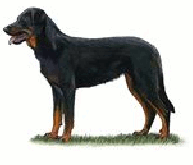- Home
- Clubs
- DogsNZ
About
Animal Welfare
Membership
Join Online
Rules and Regulations
EC Minutes and Year books
Official forms
NZ Dog World Subscription
Junior Dog Training
DNZ-Office
Executive Council
Agility Committee
Dog Training Committee
NZ Gundog Trials Assn
FAQ
Site Map
PD Insurance
Dogs NZ Insurance
Dogs NZ Insurance Breeder Partners
Lodge a Claim
- Shows
- Judges
- Dogs
- Health
- CGC
- Agility
- Breeders
- Dog Training
- Venues
- Scent Work
- Juniors
Beauceron - Information and NZ Breed Standards
Beauceron
General Information - Beauceron

Group:
Working
Beauceron
A breed standard is the guideline which describes the ideal characteristics, temperament, and appearance of a breed and ensures that the breed is fit for function with soundness essential. Breeders and judges should at all times be careful to avoid obvious conditions and exaggerations, as well as being mindful of features which could be detrimental in any way to the health, welfare or soundness of this breed.
Breed Standard - Beauceron

General Appearance: Large and solid. Unexaggerated, powerful, muscular build, without heaviness.
Characteristics: Versatile, working/sheep herding dog.
Temperament: Bold, fearless, intelligent.
Head and Skull: In proportion to body. Skull flat or slightly rounded from side to side, slight furrow between eyes. Occiput well defined. Moderate stop set midway between tip of nose and occiput. Width of skull and depth of head slightly less than half length of head. In profile, top of strong muzzle appears parallel to top of skull. When viewed from side, narrow or snipy appearance undesirable.
Eyes: Dark, oval, medium sized, with well pigmented rims. Horizontally placed.
Ears: Dropped, flat, not set close to head. Length equal to half that of head.
Mouth: Teeth strong, full dentition. Jaws strong with a perfect, regular and complete scissor bite, ie upper teeth closely overlapping lower teeth and set square to the jaws.
Neck: Muscular, blending smoothly into withers. Strong, to give proud head carriage.
Forequarters: Shoulder blade and upper arm approximately equal in length and with moderate angulation. Well defined withers. Brisket reaching elbow. Chest wide and deep. Forelegs clean and muscular, medium bone and straight when seen from all angles.
Body: Firm, level back. Ribs long and well sprung. Loin wide, very muscular. Slightly sloping croup which determines the set of the tail. Length of body from withers to set on of tail slightly longer than height at withers. Bitches may be slightly longer than dogs.
Hindquarters: Moderately angulated stifle. Vertical from low set hock joint to foot. Well muscled. Seen from behind, legs parallel. Double dewclaws set close to foot.
Feet: Strong, round, tight, turning neither in nor out. Nails black, pads hard but supple.
Tail: Carried low and hanging straight, reaching to hock and with loose hook at end.
Gait/movement: Effortless, supple and free, with good reach, to display strength and endurance in the extended trot.
Coat: Short on head. Short, rough, thick and coarse laying close to body. Approximately 3:4cm (1.25:1.5 ins) long. Slight breeching on rear of thigh and under tail. Undercoat short, fine, soft and dense, preferably light grey and not showing through topcoat.
Colour: Black and Tan - Markings rich and bright. Tan above eyes, on side of muzzle, narrowing on to cheeks but not reaching under ears. Two spots preferred on forechest rather than continuous band. Marked also on throat, under tail and on feet up to hock and pastern. Leg markings narrowing upwards on outside, but blending higher on inside. A few white hairs on chest permissible. Tricolour - Grey, Black and Tan: Coat has grey and black patches which are evenly distributed over body, with more black than grey. Tan markings as in Black and Tan.
Size: Dogs 65:70 cms (25½:27½ ins); Bitches: 63:68 cms (25:27 ins).
Faults: Any departure from the foregoing points should be considered a fault and the seriousness with which the fault should be regarded should be in exact proportion to its degree and its effect upon the health and welfare of the dog and on the dog’s ability to perform its traditional work.
Note: Male animals should have two apparently normal testicles fully descended into the scrotum
DNZ No 515
FCI No 44
Copyright Dogs New Zealand
01 Sept 2011
Any departure from the foregoing points should be considered a fault and the seriousness with which the fault should be regarded should be in exact proportion to its degree and its effect upon the health and welfare of the dog and on the dog’s ability to perform its traditional work.
Quick Links
Contact us
Looking for a puppy?
Breeder contacts
What breed of dog?
Activities for my dog
Looking after my dog
Buying a pure bred dog
Why buy a registered dog?
Join Dogs New Zealand
Show my dog
Train my dog
Other activities
Our clubs
Our magazine
Puppy and Dog Insurance
Insurance for Breeders
Looking for a puppy?
Breeder contacts
What breed of dog?
Activities for my dog
Looking after my dog
Buying a pure bred dog
Why buy a registered dog?
Join Dogs New Zealand
Show my dog
Train my dog
Other activities
Our clubs
Our magazine
Puppy and Dog Insurance
Insurance for Breeders



